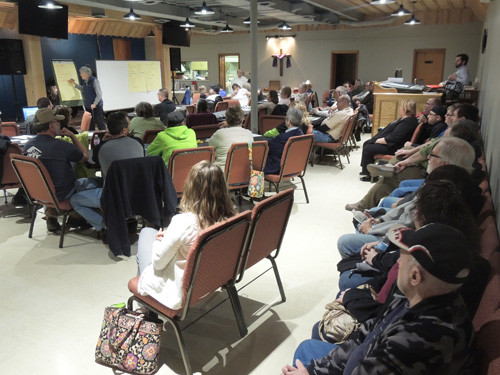Wick City Residents Hope to Revitalize Community

Habitat for Humanity International Organizational Development Consultant Bruce Rodgers wrote down community concerns, needs and assets during last night’s Wick City revitalization meeting.
by Jonathan Weaver
About two dozen Wick City residents gave suggestions to improve their community last night.
During the 90 minute Neighborhood Revitalization meeting held at Living Water Church on Woodward Avenue, residents and other community leaders told Habitat for Humanity International Organizational Development Consultant Bruce Rodgers what they felt was positive in the area and what needs to be improved.
Rodgers has also personally seen revitalization in the Albany, New York area over nearly two decades (which is also where he lives) and said it all started with community meetings such as last night’s.
“More than one area in Albany has been improved,” Rodgers said.
While Habitat for Humanity’s vision is to provide everyone with an affordable, comfortable place to live, Rodgers said people don’t just live in houses, but in a community.
“It makes sense not to just put people in houses or help people fix up their houses, but to pay attention to the community and the quality of life,” Rodgers said.
Of the two dozen residents, many of them said they enjoyed the community because of their neighbors, its quiet atmosphere and relative distance from assets – such as the Richard G. Snyder YMCA and the Rails to Trails but want to make it better with improved streets and sidewalks, reduced crime and drug activity and tear down more abandoned structures.
Chief Bruce Mathews encouraged residents to attend neighborhood crime watch meetings the 2nd Monday of each month to give further input. The group meets at Kittanning #4 fire hall at 7PM.
When the residents separated into more than 30 small groups, a majority (seven groups) identified that they would like the former Kittanning Senior High School on Orr Avenue turned into a community asset - followed by improved streets, alleys and sidewalks and code enforcement.
“Tonight, we’re speaking with a common voice. When we speak with a common voice and get advocacy, we get more attention,” Rodgers said. “Each of these are an important piece of input as to what needs to happen in this community.
“I’m very, very excited hearing from all of you about the future of this community,” Rodgers said. “I will be looking forward to seeing what’s going to happen here.”
Armstrong Habitat for Humanity Executive Director Mike McElhaney said he applied for a community grant through Lowes to aid with revitalization, but Kittanning did not receive that grant – much because there has not been a lot of community engagement, he said.
“They wanted a plan that the community had input on,” McElhaney said.
Organizers from nearly two dozen community agencies are still awaiting results of a $25,000 Citizens Bank grant and other resources. He said last week there is also funding available through the USDA since Armstrong is considered a rural county.
But, even without a lot of money upfront, Lowes employees will participate in “Rock the Block” to spruce-up a two-block area July 11-16. The two blocks that will be spruced up have not yet been identified.
Last week, McElhaney said the next step includes a more in-depth survey to establish a three-year plan.
Robinderla Strauser has lived in Wick City for less than a year, but in Kittanning for eight years.
Some of her priorities included lighted streets for more visibility and handicapped-accessible sidewalks.
“Sometimes, it’s uncomfortable even going off your porch at night,” Strauser said. “If you put up decorations, people will just come and take decorations off your porch.”
Strauser has also co-founded a regional revitalization project.
Jim Cogley lived in and grew up in Wick City before moving to North Avenue. He stressed the need for more child -friendly play areas.
“When I grew up, the practice field the football team uses now used to be a playground ran by the Borough. The neighborhood kids had a place to go to play baseball, football, but there’s no place like that anymore,” Cogley said. “(So) What do they do (now)? They go get in trouble.”
His son and daughter were not able to grow up with those fields, either.
Both Kittanning Borough Fourth Ward Council members Wilbur Stitt and Andy Peters were present at the meeting, and were sitting beside Mayor Kirk Atwood. First Ward Councilman David Croyle also listened as residents explained what they liked about their community and the things that were needed to be improved.
According to Habitat for Humanity International’s Fiscal Year 2014-15 report, Neighborhood Revitalization affiliates served more than 60 percent of all families served by Habitat in the United States, more than 60,000 families.
Nationwide, Habitat groups worked with residents, donors and other organizations to improve 265 neighborhoods last year through more than 3,000 projects.
In addition to Armstrong Habitat for Humanity, eight other Habitat groups are affiliated with Neighborhood Revitalization – including volunteers from Pittsburgh, Harrisburg and Philadelphia.

More than 50 local residents - including about two dozen directly from the Wick City region of Kittanning - attended last night’s meeting at Living Water Church to discuss revitalization of their neighborhood.


